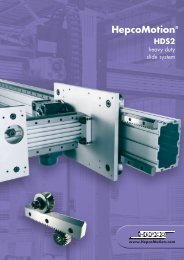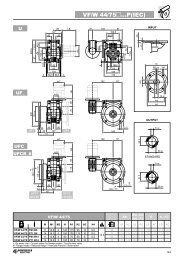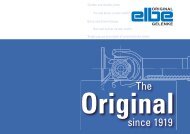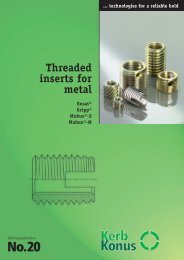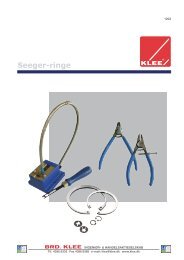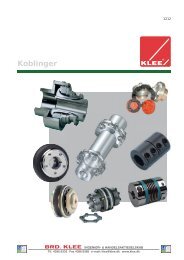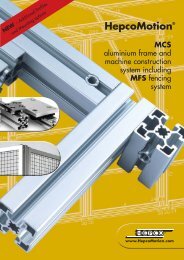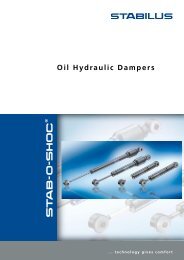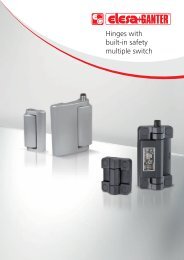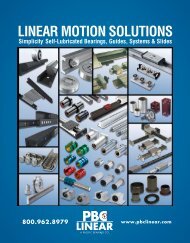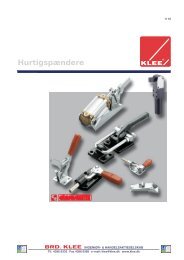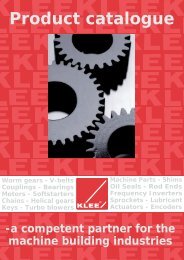Original SEEGER ® Original SEEGER ® - Brd. Klee A/S
Original SEEGER ® Original SEEGER ® - Brd. Klee A/S
Original SEEGER ® Original SEEGER ® - Brd. Klee A/S
Create successful ePaper yourself
Turn your PDF publications into a flip-book with our unique Google optimized e-Paper software.
6.<br />
Werkstoffe<br />
Materials<br />
Matières<br />
Sonderwerkstoffe<br />
Neben den genannten Kohlenstoff-Federstählen<br />
finden auch korrosionsbeständige<br />
Werkstoffe Verwendung. Folgende Materialien<br />
kommen für die Herstellung von Seeger-<br />
Befestigungselementen noch in Frage:<br />
Zinn-Bronze CuSn6 / CuSn8<br />
Zinn-Bronze zeichnet sich durch eine sehr<br />
hohe chemische Beständigkeit aus, hat jedoch<br />
eine etwas geringere elastische<br />
Dehnung als Federstahl. Insbesondere im<br />
kleineren Durchmesserbereich können die<br />
Sicherungsringe in den plastischen Verformungsbereich<br />
kommen. Dies ist besonders<br />
bei der Montage zu berücksichtigen, um<br />
möglichst einen Sitz in der Nut zu erreichen.<br />
Aufgrund des Elastizitätsmoduls von E = 115<br />
000 N/mm 2 ist bei Ringen aus Zinn-Bronze<br />
mit einer geringeren Tragfähigkeit und<br />
Ablösedrehzahl zu rechnen. Zinn-Bronze ist<br />
antimagnetisch und zeigt auch bei tiefen<br />
Temperaturen keine Tendenzen einer Versprödung.<br />
Beryllium-Bronze CuBe2,<br />
Werkstoffnummer 2.1247.75<br />
Dieser Werkstoff besitzt die gleiche Beständigkeit<br />
wie Zinn-Bronze, ist jedoch aushärtbar,<br />
d.h. er kann wie Federstahl im weichen<br />
Zustand verarbeitet und dann ausgehärtet<br />
werden. Im ausgehärteten Zustand<br />
besitzt er eine elastische Dehnung, die über<br />
der von Federstahldraht liegt. Der sehr hohe<br />
Preis der Beryllium-Bronze schränkt die<br />
Anwendung jedoch ein.<br />
Edelstahl X 39 CrMo 17 1,<br />
Werkstoffnummer 1.4122<br />
Dieser Werkstoff besitzt als härtbarer martensitischer<br />
Chromstahl nicht die Beständigkeit<br />
der austenitischen Chrom-Nickel-Stähle. Für<br />
zahlreiche Anwendungsfälle reicht dieser Stahl<br />
aus und wird vor allem für die Herstellung der<br />
kleineren und mittleren Ringe verwendet.<br />
Edelstahl X 10 CrNi 18 8,<br />
Werkstoffnummer 1.4310<br />
Dieser Werkstoff ist ein austenitischer korrosionsbeständiger<br />
Edelstahl, der besonders<br />
gute Eigenschaften für eine Kaltverfestigung<br />
besitzt. Sowohl Seeger-Ringe nach DIN<br />
471/472 in den Abmessungen über 100 mm<br />
Nenndurchmesser (konzentrische Form) als<br />
auch Sprengringe SW/SB können aus diesem<br />
Werkstoff hergestellt werden.<br />
Special Materials<br />
In addition to the above-mentioned carbon<br />
spring steels, corrosion-proof materials are<br />
also used. The following materials are still<br />
used to manufacture Seeger retaining rings:<br />
Tin bronze CuSn6 / CuSn8<br />
The particular characteristic of tin bronze is<br />
its high chemical resistance although its elasticity<br />
is somewhat lower than spring steel. In<br />
particular retaining rings of smaller diameters<br />
can be prone to plastic deformation. This<br />
must particularly be taken into account with<br />
regard to fitting in order to achieve the best<br />
possible seating in the groove. Because tin<br />
bronze rings have a modulus of elasticity of<br />
E = 115 000 N/mm2 a lower capacity and revolution<br />
count for separation must be assumed.Tin<br />
bronze is antimagnetic and, even at<br />
low temperatures, shows no tendencies towards<br />
embrittlement.<br />
Beryllium bronze CuBe2,<br />
Material number 2.1247.75<br />
This material has a higher strength than tin<br />
bronze after heat treatment. That is to say,<br />
just like spring steel it can be worked when<br />
soft and then hardened. When hardened, this<br />
material has an elastic elongation which is<br />
higher than that of spring steel. However, the<br />
use of beryllium bronze is restricted by its<br />
very high price.<br />
Stainless steel X 39 CrMo 17 1,<br />
material number 1.4122<br />
As a hardenable martensitic chrome steel,<br />
this material does not have the resistance of<br />
austenitic chrome nickel steels. This steel<br />
suffices for numerous applications and is<br />
used above all in the manufacture of smaller<br />
and medium-size rings.<br />
Stainless steel X 10 CrNi 18 8,<br />
material number 1.4310<br />
This material is an austenitic corrosion-proof<br />
stainless steel which is particularly suitable<br />
for work hardening. Both Seeger rings to DIN<br />
471/472 with dimensions of more than 100<br />
mm nominal diameter (concentric form) and<br />
circlips SW/SB can be manufactured from<br />
this material.<br />
Matières spéciales<br />
En plus des aciers à ressort au carbone, des<br />
matières résistant à la corrosion sont également<br />
utilisées. Les matières suivantes peuvent<br />
être employées pour la fabrication des<br />
éléments de fixation Seeger:<br />
Bronze à l'étain CuSn6 / CuSn8<br />
Le bronze à l'étain est caractérisé par une<br />
très grande résistance chimique, mais a toutefois<br />
une élasticité un peu moins importante<br />
que l'acier à ressort. En particulier pour les<br />
petits diamètres, les segments d’arrêt peuvent<br />
atteindre le domaine de déformation<br />
plastique. Ceci doit surtout être pris en considération<br />
pour le montage afin d’obtenir<br />
autant que possible un bon positionnement<br />
dans la gorge. En raison du module d'élasticité<br />
de E =115000 N/mm2, il faut pour les<br />
segments en bronze à l’étain compter avec<br />
une capacité de charge et une vitesse de rotation<br />
admissible diminuées. Ce bronze à<br />
l’étain est anti-magnétique et n’a pas tendance<br />
à devenir cassant à basse température.<br />
Bronze au béryllium CuBe2,<br />
numéro de matière 2.1247.75<br />
Cette matière a la même résistance que le<br />
bronze à l'étain, mais peut être trempée. c.-ad.<br />
qu'elle peut être transformée à l'état mou,<br />
puis trempée comme l'acier à ressort. Une<br />
fois trempée, elle a une élasticité supérieure<br />
à celui de l'acier à ressort. Le prix très élevé<br />
du bronze au béryllium limite néanmoins ses<br />
applications.<br />
Acier X 39 CrMo 17 1,<br />
numéro de Matière 1.4122<br />
Cette matière, de l'acier au chrome martensitique<br />
pouvant être trempé, n'a pas la résistance<br />
des aciers austénitiques au chromenickel.<br />
Néanmoins, il convient à de nombreuses<br />
applications. Il est utilisé avant tout<br />
pour la fabrication de petits et moyens segments<br />
d’arrêt.<br />
Acier X 10 CrNi 18 8,<br />
numéro de matière 1.4310<br />
Cette matière est un acier spécial austénitique<br />
résistant à la corrosion qui présente d'excellentes<br />
propriétés pour un écrouissage. Il est possible<br />
de fabriquer des segments d'arrêt Seeger<br />
DIN 471/472 d'un diamètre nominal supérieur à<br />
100 mm (forme concentrique) ainsi que des anneaux<br />
expansifs SW/SB avec cette matière.<br />
Bezeichnung / Designation / Désignation Cu Sn 8 Cu Be 2<br />
Werkstoff-Nr. / Material No. / N° de Matière 2.1030.34 2.1247.75<br />
E-Modul / E-Mod of elasticity / E-Module d'élast. [N/mm 2 ] 115.000 132.500<br />
spez. Gew. / specific gravity / Masse spécif. [g/cm 3 ] 8,9 8,3<br />
R e [N/mm 2 ] 600 1200<br />
R m [N/mm 2 ] 720 1300<br />
[%] 0,52 0,87<br />
114



